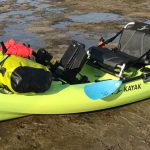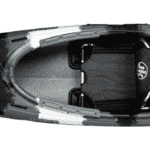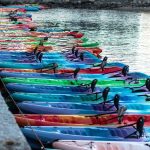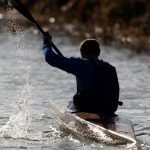Picking the right kayak for your weight is really important to keep you safe on the water and to help you get the most out of your paddling.
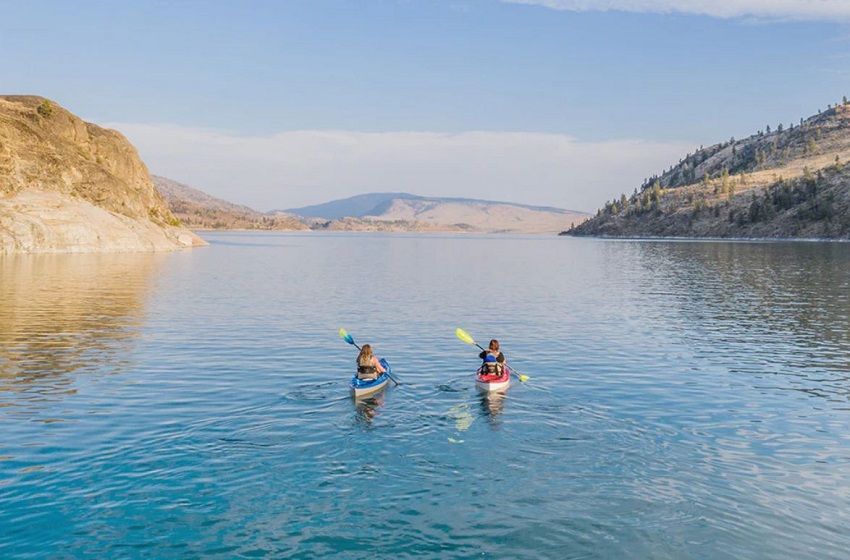
Kayak length is one of the key factors that determine where and how you can paddle your kayak. 12 feet kayaks are seen by many as the perfect balance, the magic length, that fits the bill for every style of recreational kayaking. These 12-foot-long kayaks can negotiate the twists and turns of a river environment, but also cover the water and even be used to fish.
But not all 12-foot-long kayaks are made the same. Sure, they might all be the same length, but with so many other factors that affect their performance and suitability, there’s more to kayaking life than length alone. We’ve unpacked our favorite 12-foot-long kayaks, just for you.
As an affiliate of Amazon and other retailers, we may earn a small commission when you buy via our links, at no additional cost to you. Thank you!
At a Glance: The Best 12-Foot Kayaks
- Best Overall: Crescent LiteTackle
- Most Versatile: NuCanoe Unlimited
- Best Recreational: Wilderness Systems Pungo 120
- Best Performance: Eddyline Caribbean
- Best SUP Hybrid: Vibe Cubera 120
- Best Motorized: Old Town Sportsman AutoPilot 120
- Best for Families: Vibe Skipjack 120T Tandem
- Best for Sit-in Day Touring: Perception Carolina 12.0
- Best Inflatable: Sea Eagle 385 FT
- Best for Rivers: Dagger Axis 12.0
Comparison Table: The Best 12-Foot Kayaks
| Model | Specs | Where To Buy |
Crescent LiteTackle | Length: 12 ft. 4 in. x 34 in. Capacity: 450 lbs. Weight: 75 lbs. | Crescent Kayaks |
 NuCanoe Unlimited | Length: 12 ft. 6 in. x 41 in. Capacity: 650 lbs. Weight: 84 lbs. | Eco Fishing Shop |
Wilderness Systems Pungo 120 | Length: 12 ft. 2 in. x 29 in. Capacity: 325 lbs. Weight: 49 lbs. | Amazon |
 Eddyline Caribbean | Length: 12 ft. 2 in. x 30 in. Capacity: 275 lbs. Weight: 45 lbs. | Eddyline |
Vibe Cubera 120 | Length: 12 ft. x 33.5 in. Capacity: 475 lbs. Weight: 78 lbs. | Elelectric Surf Sports |
Old Town Sportsman AutoPilot 120 | Length: 12 ft. x 37 in. Capacity: 406 lbs. Weight: 152 lbs. | Amazon |
Vibe Skipjack 120T Tandem | Length: 12 ft. 2 in.x 35 in. Capacity: 500 lbs. Weight: 72 lbs. | Amazon |
Perception Carolina 12.0 | Length: 12 ft. x 26 in. Capacity: 275 lbs. Weight: 49 lbs. | Amazon |
Sea Eagle 385 FT | Length: 12 ft. 5 in. x 36 in. Capacity: 635 lbs. Weight: 35 lbs. | Amazon |
Dagger Axis 12.0 | Length: 12 ft. x 27.5 in. Capacity: 350 lbs. Weight: 55 lbs. | Amazon |
The Best 12-Foot Kayaks
Best Overall: Crescent LiteTackle

Length: 12 ft. 4 in. (376 cm)
Width: 34 in. (86 cm)
Capacity: 450 lbs. (204 kg)
Weight: 75 lbs. (34 kg)
The Crescent LiteTackle may be designed as a fishing kayak at heart, but that doesn’t limit this kayak to only being used by keen anglers. The wide and stable profile, the high comfortable seat, and the elongated keel line all combine to make this kayak ideally suited to recreational kayakers of all levels. The fact that it comes in at under a thousand dollars doesn’t hurt either.
One of the most common limiting factors to time on the water is your comfort. The large open deck design of the LiteTackle lets you can stretch out and even stand and move around. The seat is designed with extra lumbar support, to tackle that lower back pain that kayakers often feel after a few hours on the water.
Crescent has given the LiteTackle a defined keel line that is slightly extended at the stern to increase straight-line speed and tracking. The bow rocker helps to cut through waves, to give you a high and dry ride, so you don’t end up waterlogged. Alongside the keel, the hull flattens out to provide a high level of primary stability, so you can stand and cast if you’re an angler, or just enjoy how easy this kayak is to get on and off.
Pros:
- Stable enough to stand up
- Reasonable top speed and tracking
- Comfortable seating
- Open design
- Affordable
Cons:
- Low seating position can affect angling, or your paddling position
Most Versatile: NuCanoe Unlimited
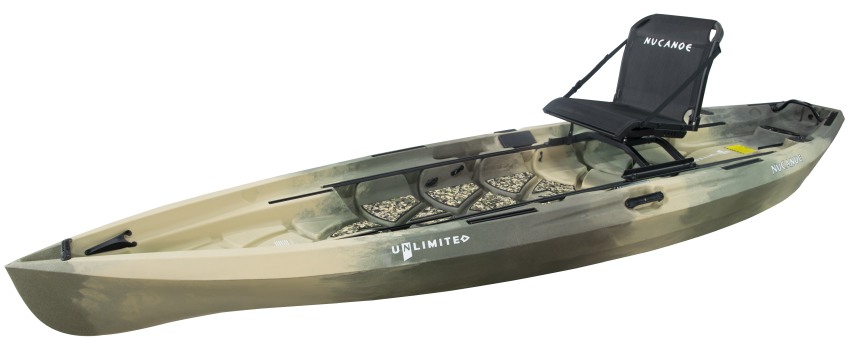
Length: 12 ft. 6 in. (381 cm)
Width: 41 in. (104 cm)
Capacity: 650 lbs. (295 kg)
Weight: 84 lbs. (38 kg)
Unlimited by name, unlimited by nature. The NuCanoe Unlimited is an open-design kayak that you can use to explore rivers, lakes, and ocean breaks. You can fish or hunt from this kayak, and it can be used with pedal driver systems or almost any kind of motor.
The enormous open deck design makes the Unlimited one of the most accessible kayaks on the market, and coupled with the enormous width – 41 inches – you can stand, move about, and easily climb aboard this kayak. Despite this width, the NuCanoe Unlimited doesn’t feel sluggish on the water. It’s never going to break records – but at this length, it’s not designed to – but it doesn’t drag and wear you down as some other wide kayaks can.
There may be no designed storage areas onboard the kayak as such – no bungee to secure them, or molded tank wells – but with so much open space there’s no way you’re going to struggle to bring everything you need onboard. For setting up your ride the way you want to, NuCanoe has fitted gear tracks almost the full length on either side of the kayak. And perhaps our favorite feature is the full 360° rotating seat, so you can spin all the way around if you need to cast from the side or back of your kayak.
Pros:
- Versatile design
- Wide and extremely stable
- Deck padding throughout
- Fully rotating seat
- Good tracking and speed
- Motor ready
Cons:
- No way to secure your gear or keep it from moving about
- Limited space behind the seat
Best Recreational: Wilderness Systems Pungo 120

Length: 12 ft. 2 in. (3.71 m)
Width: 29 in. (74 cm)
Capacity: 325 lbs. (147 kg)
Weight: 49 lbs. (22 kg)
The Wilderness Systems Pungo is one of the best sit-in recreational kayaks on the market. The Pungo 120 is the 12-foot version of this and sits as the mid-size kayak in the Pungo range. One of the most striking features of the Pungo is the large open cockpit. This makes the kayak accessible for paddlers of all levels – and shapes – who can sit comfortably, safe in the knowledge they aren’t going to be trapped in the event of a capsize.
At the front of the Pungo’s large cockpit is the kayak dashboard. This features a dry storage case for your phone, two cup holders, and a recess for a lithium-ion battery, so you can charge on the go. Recreational kayakers tend to love having phones, cameras, and coffees close at hand on the water, and this dashboard gives you space to stow all of this without having to dig it out of a dry bag when you need it.
The Pungo is an all-around recreational kayak. It’s best suited to touring style trips, given the narrower profile and long waterline, but the small rocker kick and rounded top deck make this suited to rivers too – but only low classes of rapids. The Pungo is fitted with a comfortable and ventilated mesh seat, so wherever you take it, you can paddle in cool comfort all day.
Pros:
- Versatile sit-in style kayak
- Good top speed
- Large open cockpit
- Kayak dashboard
- Comfortable and supportive seating
Cons:
- Suited to smaller framed kayakers
Best Performance: Eddyline Caribbean

Length: 12 ft. 2 in. (3.66 m)
Width: 30 in. (76 cm)
Capacity: 275 lbs. (125 kg)
Weight: 45 lbs. (20.5 kg)
The Eddyline Caribbean is something of an outsider in the world of sit-on-top kayaks. Where most sit-on-top kayaks are wide platforms designed around stability, the Caribbean is designed for smooth performance and distance kayaking. This kayak is made from Eddyline’s Carbonlite 2000 material, a lightweight and durable ABS design that gives you strength without excess weight.
Despite the narrower profile, the Caribbean still manages to retain a good level of primary stability and doesn’t rely on edges for you to feel secure. The soft chines and engaging edges do allow you to get slightly more turning control than many sit-on-tops offer, but without thigh straps, you still rely mainly on the paddle. This isn’t a kayak for sharp turns though, with a defined keel line and low rocker profile, this is a sleek kayak that has a high top speed.
Secure storage at the bow and a large well at the stern, complete with drainage and secure bungee, give you space to stow day tripping or overnight camping equipment. The comfortable seat and footpegs keep you out on the water all day, too. This is a kayak that screams exploration, and Eddyline has made sure there’s nothing to stop you from going as far as possible.
Pros:
- Smooth and sleek design
- Strong ABS build
- Stable despite being narrow
Cons:
- Expensive
- Low capacity
Best SUP Hybrid: Vibe Cubera 120

Length: 12 ft. (3.66 m)
Width: 33.5 in. (85 cm)
Capacity: 475 lbs. (215 kg)
Weight: 78 lbs. (35 kg)
If you’re looking for a 12-foot kayak with unparalleled access to the water, then the Vibe Cubera 120 is probably the kayak for you. This kayak and paddle board crossover design is low profile and easy to access. Whether you deck this kayak out with a seat or leave it open to stand and paddle from is up to you, but either way, you’re going to have a stable and easy-to-maneuver platform.
At its heart, the Cubera 120 is a fishing platform, with superior command of the water and standing capabilities. The flat hull design allows you to take this kayak into shallower regions of lakes that most kayaks would ground out, or become hard to paddle in. This flatter design does have limitations though, and the Cubera 120 is not a kayak that will hold its course against the wind, or be able to push out long days of kayaking.
Beyond its fishing prowess, the Cubera 120 is a versatile paddleboard design that can be used in a whole range of environments. In wind or chop, you’re going to get a wet ride, but you’re also safe in the knowledge that if you do fall off, it’s easy to climb back aboard. If you want to sit back and relax, the framed seat offers a good level of support and comfort, and just slots in easily to the rails fitted into the kayak.
Pros:
- Kayak paddleboard crossover
- Open and unclutter
- Superb stability
- Comfortable removable seat
Cons:
- Flat design limits capabilities in wind
- Low top speed
- Wet ride and no protection from wind and waves
Best Motorized: Old Town Sportsman AutoPilot 120

Length: 12 ft. (3.66 m)
Width: 37 in. (94 cm)
Capacity: 406 lbs. (184 kg)
Weight: 152 lbs. (69 kg)
Sometimes, you want to get where you’re going hands-free. Whether you’re taking photos on the way, trawling fishing lines, or just saving your energy for a full day of casting, motor kayaks have a whole load of different uses. The Old Town Sportsman AutoPilot 120 uses a Minn Kota electric motor, controlled by a Bluetooth remote control, to give you the ultimate freedom to sit back, relax, and take in your surroundings.
There’s more to the motor than that, though. With GPS technology, you can automatically set the motor to take you to your chosen location, and once you arrive, you can stay there thanks to the Spot-Lock setting that holds you in place. Now, all of this tech doesn’t come without some bulk, and with a weight of 152 lbs., you’re going to want a serious trailer to move this kayak to and from the water.
There’s a lot of kayak away from the motor, too. This wide, stable platform is fully tournament fishing ready, with deck pads, a raised seating position, plenty of storage, as well as rod holders, tackle box storage, and gear tracks around the edges. The Sportsman AutoPilot 120 is a serious fishing machine, so unless you plan to use it to its full potential, there’s probably a better kayak on this list for you.
Pros:
- Autopilot motor with Bluetooth control and Spot-Lock setting.
- Wide and stable kayak
- Competition ready fishing setup
Cons:
- Heavy
- Expensive
- Unnecessary if you aren’t a keen angler, or don’t need the motor
Best for Families: Vibe Skipjack 120T Tandem

Length: 12 ft. 2 in. (3.7 m)
Width: 35 in. (89 cm)
Capacity: 500 lbs. (227 kg)
Weight: 72 lbs. (33 kg)
12 foot might seem a little compact for a tandem family kayak, but the Vibe Skipjack 120T has enough space for two adults to get comfortable, as well as a space for a young kayaker in the center. This kayak is an affordable option for those getting into the sport, or for anyone that wants a spare for visiting friends and family. The Skipjack 120T is not a feature-laden kayak, but exhibits recreational simplicity and ease of use.
The hull design itself is almost as well-rounded as they come. It’s wide and stable, but without adding excess drag where it’s not needed. The elongated keel line at the rear gives the kayak a slightly better top speed, while the sharp bow rocker kick lets you ride high and dry over waves, as well as keeping you turning more easily. This is a kayak for calm environments, but suits small ocean surf and swell, and gentle moving rivers.
The simplicity and stature of the Skipjack 120T do mean that there isn’t a whole load of room onboard for storage. Small storage wells at the bow and stern give you a little room, and if you’re not paddling with a third passenger, you can always stow a dry bag in the middle. The setas are basic but comfortable enough, and you can always upgrade them if you find yourself wanting to stay out for longer.
Pros:
- Affordable recreational kayak
- Well rounded hull design
- Stable
- Easy to paddle
Cons:
- Seat pads require upgrading if you choose to stay out for longer
- Limited storage space
Best for Sit-in Day Touring: Perception Carolina 12.0

Length: 12 ft. (3.66 m)
Width: 26 in. (66 cm)
Capacity: 275 lbs. (125 kg)
Weight: 49 lbs. (22 kg)
The Perception Carolina is a mid-sized sit-in day touring kayak, fully rudder ready, and capable to take you to the boundaries of your local lake and even on short overnight trips. This closed cockpit kayak features an elongated waterline and low rocker profile, to maximize speed and efficiency over the water. The flat profile of this kayak does limit its turning speed though, so you won’t want to take the Carolina 12 into any tight spots.
One of the most noticeable features of the Carolina 12 is the narrow beam. For beginners or kayakers who are stepping from a sit-on-top, this kayak is likely to feel unstable at first. Once you get accustomed to it, though, this kayak is smooth and elegant over the water.
Perception has a history of making quality, affordable kayaks, and the Carolina is no exception to this. Coming in at around $500, this is a highly affordable choice for recreational kayakers who want to push their boundaries a little further. Despite this affordable price point, the Perception Carolina 12 still has a comfortable, supportive seat system, and two watertight hatches for storing equipment on the water.
Pros:
- Affordable touring kayak
- Good storage options
- Flatter profile for enhanced tracking and speed
- Rudder ready
Cons:
- Poor turning capabilities
Best Inflatable: Sea Eagle 385 FT
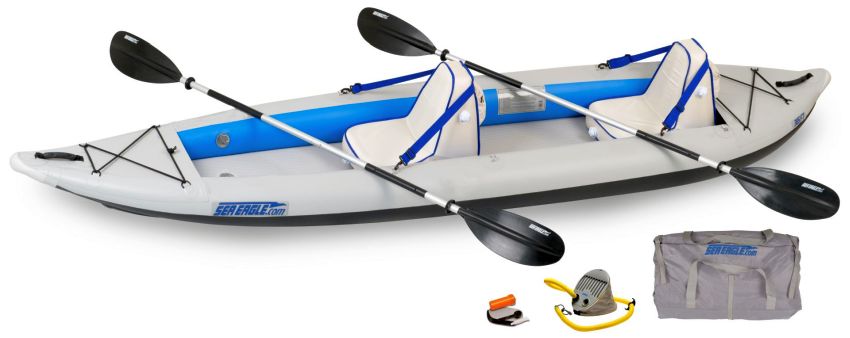
Length: 12 ft. 5 in. (3.81 m)
Width: 36 in. (91 cm)
Capacity: 635 lbs. (288 kg)
Weight: 35 lbs. (16 kg)
The Sea Eagle 385 FT is a 12-foot long kayak that lets you avoid the hassle of finding 12 feet of storage space or transport room. This inflatable kayak packages down into the trunk of your car, or a cupboard at home, and inflates in under ten minutes. The 385 FT is sold as a three-person kayak but realistically fits two adults comfortably.
It might be inflatable, but that doesn’t mean that the Sea Eagle 385 FT is limited in its abilities. This is a touring-specific inflatable kayak, and uses a NeedleKnife keel, with a pronounced extra tube at the bow, to grip the water and give you enhanced tracking. A swept-back skeg at the rear helps this further, and the flatter section of the hull in the center keeps you stable and enhances the turning abilities of the 385 FT.
The floor of the 385 FT is made from I-beam designed chambers, giving additional structural support to prevent collapse. The side chambers are lower than most traditional inflatables, so you can reach over them more easily and paddle with less difficulty. These side walls do leave you a little more exposed to waves crashing over the kayak, though, so Sea Eagle has fitted small spray skirts at either end to prevent excess water from entering the kayak.
Pros:
- Moveable inflatable seats
- Can add a motor transom easily
- Easy storage and transport
- Good tracking for an inflatable
Cons:
- A tight fit for three adults
- Low sides leave you exposed to waves
- Inflatable kayaks are more susceptible to the wind
Best for Rivers: Dagger Axis 12.0

Length: 12 ft. (3.66 m)
Width: 27.5 in. (70 cm)
Capacity: 350 lbs. (159 kg)
Weight: 55 lbs. (25 kg)
The Dagger Axis 12.0 is a crossover river kayak, suited to rivers up to class III, as well as having capabilities on long stretches of open water. The hull of this kayak is inspired by white water designs, like Dagger’s ever-popular Mamba, perhaps the most paddled creek boat in the US in the past decade.
The upturned nose and rounded hull are white water kayak-esque, giving the kayak the ability to ride high and dry as well as turn on a dime. However, Dagger has added a slight v-shape to the hull, and an elongated keel line, that combines to give you a higher top speed and better tracking against the wind. The skeg at the rear of the Axis 12.0 can be dropped for open water legs, to reduce the strain on you and reliance on your paddle to maintain a straight line.
This crossover feel continues with the outfitting. The Contour CFS outfitting is a higher-backed and more supportive version of Dagger’s white water outfitting but doesn’t have the same tight connectivity that can feel restrictive after a few hours. The slide pegs are easy to adjust and give you internal space to stretch out if you don’t need to be quite so engaged for a moment.
Pros:
- River crossover kayak
- Hull design balances turning and straight-line speed
- Storage hatch at the stern
- Comfortable and spacious outfitting
Cons:
- Thigh braces often sold separately
Why Choose a 12-Foot Kayak
12-foot kayaks are often seen as the ideal balance between speed and maneuverability. This makes them a great choice for recreational paddlers, especially those who want a ‘one kayak fits all’ type of boat. If you’ve not got the space or financial backing to fill your garage with every type of kayak, finding a boat that does a bit of everything is the best choice.
Shorter kayaks, usually around the 7 – 9 feet long region, are the chosen boats of whitewater kayakers, who require the maneuverability and rapid acceleration of a short kayak. But these have a limited top speed and are not suited to open water trips. Longer kayaks, between 13 – 17 feet long, are used on the sea, or on long touring trips. The elongated waterline gives you a higher top speed and glide over the water, but does limit turning potential and the narrower profile associated with longer kayaks makes them feel less stable.
Where Can You Paddle a 12-Foot Kayak?
One of the reasons that 12-foot-long kayaks are so popular is that you can paddle them almost anywhere. Sure, they are limited at the top end of some environments, and you would want a specialist kayak if you were pushing your white water or sea kayaking skills, but generally, a 12-foot kayak can be used on lakes, rivers, and in the ocean.
The all-around speed and balance of a 12-foot kayak make them popular with beginners, too. If you’ve never kayaked before, you’ll find that a 12-foot kayak will usually fit the bill to get you exploring feeling comfortable, and well-balanced.
How to Pick Your 12-Foot Kayak
Style
The first thing to decide when it comes to picking your 12-foot kayak is whether you want a specific style. Sure, these kayaks can do a bit of everything, but there are still those better suited to fishing, kayak camping, or river trips. Alternatively, if you want a kayak that is a true Jack of all trades, then it’s worth searching for a model that balances all the attributes you need.
Width
Kayaks at 12-foot in length can still vary in their width. Width varies from model to model, even among recreational kayaks, but the general rule is that a wider kayak is going to feel more initially stable than a narrower kayak. Fishing-specific kayaks tend to be among the widest and most stable kayaks on the market, especially those designed for you to stand and cast from.
Narrower kayaks, like touring kayaks, tend to be sit-in models. These are designed as sleeker, faster models that can cover the ground more efficiently. Without the extra drag that comes with a wider model, they can cruise over the water and feel almost effortless to paddle. Narrower kayaks are often less suited to turning in tight spaces, and rely more on secondary stability, feeling unstable for beginner kayakers.
Capacity
The capacity of your kayak is often linked to the width, with wider 12-foot long kayaks often having a higher capacity. But this isn’t always the case, so check your capacity before you presume that your kayak will comfortably carry you and all of your equipment.
The capacity of a kayak is worked out as the amount of weight a kayak can carry and still remain afloat. Just being afloat won’t be enough for your kayak to perform as it should, so it’s recommended that you don’t exceed 70% of the kayak’s stated capacity. Lower than 70% is viewed as the ‘optimal performance’ range and will keep your kayak paddling as the designer intended.
Weight
Finally, you need a kayak that you can get to the water, and load up on your cartop or trailer. 12-foot kayaks vary in weight, but most are going to require two adults or a trailer to move without risking damaging your back. Remember that any storage system you build, like racking or a pulley system to haul your kayak to the roof of your garage, should be able to take the weight of your kayak.
Lighter kayaks are usually more expensive than heavier models. The materials and design that go into reducing the weight cost money after all. You can usually strike a balance between finding a kayak that weighs an acceptable amount but won’t break the bank. Some kayaks, like fishing-specific kayaks, end up far heavier, but this is usually because of features onboard that add to the weight. If you don’t need these features, you can save on weight by buying a stripped-down kayak.

